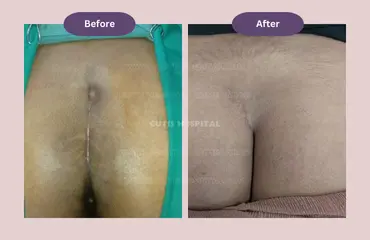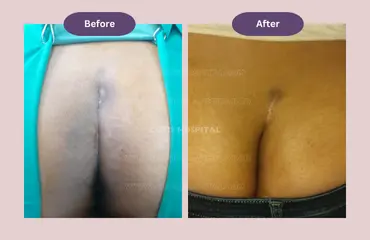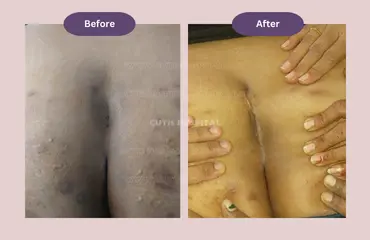Pilonidal sinus is an infection that occurs in the natal cleft (deep furrow between two buttocks) region. It usually happens to young individuals with significant hair growth around the affected area. Though the acute exacerbation of this condition can be treated with antibiotics, antibiotics provide only temporary relief. A permanent cure is possible by a plastic surgical operation called complete excision of sinus tract with direct closure or reconstruction by a flap.
Pilonidal sinus is an abnormal communication between two openings in the skin of the natal cleft region with some distance between the two openings and a bridge of normal skin overlying the abnormal communication. The abnormal communicating tract between both the openings of the sinus is usually filled with hairs and unhealthy and infected granulation tissue.
Symptoms of pilonidal sinus include pus discharge and pain. Both of these symptoms are not always present. This is the main reason many of the patients with pilonidal sinus ignore this problem and present very late for treatment.
pilonidal sinus usually starts the same way as those of simple infection or boil after removal or avulsion of hair. It happens in the region of the gluteal cleft as a boil and if unchecked, can get converted to an abscess or pilonidal abscess. This pus-filled cavity heals apparently after rupture of its contents (mostly pus) only to progress in depths and come out on the surface of the skin at another point some distance from the original opening. Thus, there is a tract running below the skin which connects two openings in the skin. Excessive hairs in the gluteal region and sitting for prolonged hours are said to be the two most important reasons for the development of pilonidal sinus. Another less well-understood yet, clinically noticeable factor is obesity and/or prominent buttocks. Boys and girls affected with pilonidal sinus are most commonly noticed to have prominent and tight buttocks.
Risk factors for pilonidal sinus are prominent buttocks with deep gluteal cleft, excessive hair growth in the natal cleft region, sitting for prolonged hours and poor local hygiene. Carelessness and casual approach after folliculitis in the gluteal region is also responsible for progression of this problem.
Avoiding the prolonged sitting, maintenance of hygiene in the natal cleft area, regular shaving of hairs and weight reduction to decrease the prominence of gluteal region are the important preventive measures for pilonidal sinus. Slightest doubt or confirmation of even a minor infection must promptly be addressed by visiting a qualified and experienced plastic surgeon.
In the early stages, treatment is directed towards treating the acute infection and strictly enforcing preventive measures. Regular trimming of hairs, maintenance of local hygiene, reduction of weight and avoidance of prolonged sitting positions are important preventive measures. Pilonidal sinus with recurrent infections, long history, and complicated branching pattern of sinus tract requires radical excision and reconstruction by aplastic surgical approach.
Surgery: Surgery for pilonidal sinus tract is not very difficult for a plastic surgeon. However, identification of whole of the sinus tract along with its internal branching is must before surgery. And M.R.I. is the best investigation tool for this type of detailed imaging. After thorough definition of the pilonidal sinus tract and all its ramifications is clear, surgery is performed for en-bloc (complete) removal of pilonidal sinus by a plastic surgeon. After complete removal, there results a significant sized defect (gap) in the middle of both gluteal regions. Plastic surgeon has different options to close this defect which include direct repair, local advancement flaps and local rotation flap. Old method of leaving this gap open to heal by secondary intention (multiple dressings) which can last up to 3 months is obsolete now.
Results of surgery for pilonidal sinus are excellent, when performed by a plastic surgeon. Complete excision with direct closure or closure by any of the two plastic surgical methods of closure brings cure of this problem. However, to maintain this result permanently, patient must follow the post operative protocols of avoiding supine and sitting positions for at least 3 weeks and maintenance of hygiene of gluteal cleft for life time.
At Cutis Hospital, all patients with pilonidal sinus are examined and counselled by our experienced plastic surgeon. And causative factors of this disease, its investigations, surgery techniques and post-operative protocols are explained to the patient and his/her relatives by our plastic surgeon himself. At, Cutis Hospital patients are referred for recurrent or previously failed pilonidal sinus surgeries and they are treated with the same protocols. In fact, patients with recurrent disease and failed surgeries need extensive counseling and reassurance before they are advised for surgery. Our plastic surgeon prefers to counsel these patients at least twice before the surgery to lessen their apprehension and boost their confidence.




Pilonidal sinus starts with a simple infection of hair follicle. Unchecked, it progresses in the depths and forms a swelling called pilonidal cyst. When this cyst gets infected, it forms an abscess or pilonidal abscess. This abscess is apus filled cavity, which ruptures
on the surface leading to resolution of symptoms and apparent healing of the problem. However, loose hairs which have entered in the pilonidal cyst, keeps coursing below the skin along with pus flakes and they create another abscess at distant site. Rupture of this abscess at a site different from the initial pilonidal abscess is responsible for creation of fully developed pilonidal sinus tract with two abnormal openings on either side connected by a tunnel filled of hairs and infected granulation tissue lying under the skin.
No, fully developed pilonidal sinus tract with two openings at either end cannot be cured of its own.
If untreated, pilonidal sinus disease can keep on creating disturbances in the form of repeated infections, swelling, pain and pus discharge. During acute exacerbation of the disease, it is very difficult for the patient to sit or lie down in supine position. Thus, the quality of life of the patient is compromised. Apart from these repeated episodes of infection, if pilonidal sinus disease is allowed to progress relentlessly, it can form multiple ramifications (branches) and can make complete removal a really challenging task with need of major plastic surgical reconstruction to cover the defect (gap).
Infected wound would cause pain, swelling, redness and sometimes pus discharge. Pus discharge many a times results in resolution of the symptoms.
Diagnosis of pilonidal sinus disease is done by history and physical examination of the patient. It is purely a clinical diagnosis, which do not require investigations to support the diagnosis. However, for identification of hidden branches of the pilonidal sinus tract and to assist in the operative planning of surgery, M.R.I. is an essential diagnostic tool.
Yes, a pilonidal cyst may develop during pregnancy. It can be treated with conservative means of antibiotics and supportive drugs. Selection of antibiotics in a pregnant woman must be done after consultation with a gynecologist.
Persons with pilonidal cyst do not necessarily have to miss their work. However, conversion of pilonidal cyst to pilonidal abscess causes extreme pain and compels the person to seek medical advice and rest.
Cutis Hospital is conveniently located in Ghatlodia, Ahmedabad, making it easily accessible via multiple modes of transportation. Below are the various ways you can reach our facility:
Sardar Vallabhbhai Patel International Airport: Located approximately 12.7 km from Cutis Hospital, offering convenient access for patients traveling from outside the city.
Chandlodiya Railway Station: Approximately 2.4 km from Cutis Hospital.
Ahmedabad Railway Station: Around 11 km from our center.
GSRTC:
Ahmedabad Central Bus Station (GSRTC): About 10.3 km from the hospital.
AMTS:
Bhuyangdev Cross Road Bus Stop: Just 500 meters from Cutis Hospital.
BRTS:
Bhuyangdev BRTS Bus Stop: Only 170 meters from our center.
We provide effective surgical and non-surgical treatments for all parts of the body. At Cutis Hospital, our cosmetic and plastic surgery team is committed to giving patients safe and high-quality care.